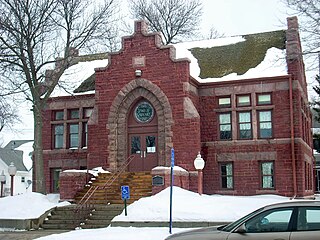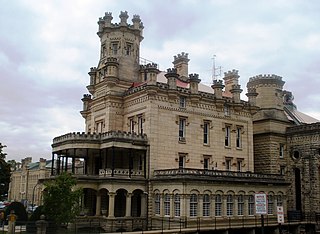Thomas Wilson Williamson (August 4, 1887 Hiawatha, Kansas [1] – November 16, 1974) was a Kansas architect who specialized in designing school buildings in Kansas, Iowa, and Missouri.

Hiawatha is the largest city and county seat of Brown County, Kansas, United States. As of the 2010 census, the city population was 3,172.

Kansas is a U.S. state in the Midwestern United States. Its capital is Topeka and its largest city is Wichita, with its most populated county being Johnson County. Kansas is bordered by Nebraska on the north; Missouri on the east; Oklahoma on the south; and Colorado on the west. Kansas is named after the Kansa Native American tribe, which inhabited the area. The tribe's name is often said to mean "people of the (south) wind" although this was probably not the term's original meaning. For thousands of years, what is now Kansas was home to numerous and diverse Native American tribes. Tribes in the eastern part of the state generally lived in villages along the river valleys. Tribes in the western part of the state were semi-nomadic and hunted large herds of bison.

An architect is a person who plans, designs and reviews the construction of buildings. To practice architecture means to provide services in connection with the design of buildings and the space within the site surrounding the buildings that have human occupancy or use as their principal purpose. Etymologically, architect derives from the Latin architectus, which derives from the Greek, i.e., chief builder.
Contents
Williamson grew up in Topeka, Kansas [1] and is best known for designing Topeka High School, a magnificent Perpendicular Gothic public high school, completed in 1931. Assisting Williamson was his chief designer Ted Greist, and Linus Burr Smith from Kansas State College (now Kansas State University) to oversee the plans.

Topeka is the capital city of the U.S. state of Kansas and the seat of Shawnee County. It is situated along the Kansas River in the central part of Shawnee County, in northeast Kansas, in the Central United States. As of the 2010 census, the city population was 127,473. The Topeka Metropolitan Statistical Area, which includes Shawnee, Jackson, Jefferson, Osage, and Wabaunsee counties, had a population of 233,870 in the 2010 census.

Topeka High School (THS) is a fully accredited high school, serving students in grades 9–12, located in Topeka, Kansas. It is one of four high schools within Topeka Public Schools. In the 2010-2011 school year, there were 1,840 students enrolled.

Kansas State University (KSU), commonly shortened to Kansas State or K-State, is a public research university with its main campus in Manhattan, Kansas, United States. Kansas State was opened as the state's land-grant college in 1863 and was the first public institution of higher learning in the state of Kansas. It had a record high enrollment of 24,766 students for the Fall 2014 semester.
Williamson and Griest also designed Clay Elementary School (now Cair Paravel-Latin School), which was completed in 1926.

Cair Paravel Latin School is a private, coeducational, non-profit, non-denominational Christian school located in Topeka, Kansas. The school was founded in 1980. With over 300 students, Cair Paravel is the largest school in Kansas offering a Classical Christian education. Cair Paravel is a member of the Association of Classical Christian Schools.
Thomas W. Williamson (1887-1974), whose full name was Thomas Wilson Williamson, was an American architect. He practiced architecture for more than 50 years, designing schools and courthouses in Kansas and neighboring U.S. states. A number of his works were listed on the U.S. National Register of Historic Places for their architecture. [2] Firm names including him operated as Thomas W. Williamson and Company, as Thomas W. Williamson, Victor H. Loebsack & Associates, and later as Williamson-Loebsack and Associates. The firm grew to a size of 46 architects, draftsmen, engineers and other specialists. [3]

The National Register of Historic Places (NRHP) is the United States federal government's official list of districts, sites, buildings, structures, and objects deemed worthy of preservation for their historical significance. A property listed in the National Register, or located within a National Register Historic District, may qualify for tax incentives derived from the total value of expenses incurred preserving the property.










